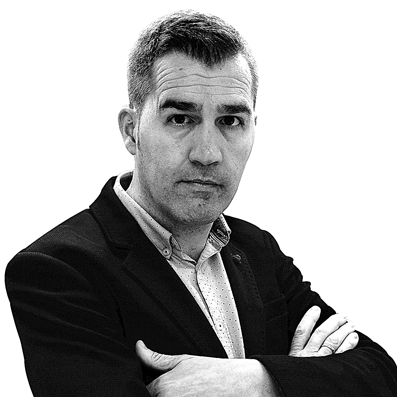A member of the penitential brotherhood places a painting in one of the rooms of the temple. /
Valladolid
The Brotherhood of the Holy Passion of Christ has a rich heritage
The history of the capital is inextricably linked to the future of the Brotherhood of the Holy Passion of Christ. A chronology of more than five centuries that runs parallel to the very evolution of Holy Week in Valladolid, from its birth in 1531 to its most modern reforms, passing through the times of splendor and of the great image-makers to more convulsive times. And these facts make this penitential one of the ones that treasures the most assets: from real estate to sculpture, pictorial, documentary and all the belongings, ornamentation and clothing related to the development of religious and processional exercises. Specifically, historians originally attribute to them a hermitage or shrine next to the Puente Mayor, but the growing spirituality led them to build their own temple – the current municipal exhibition hall of the Passion – where their devotional heritage began to increase with great and great works of polychrome wood up to the present day, where its particular inventory exceeds one hundred pieces. And this amount of heritage is precisely what makes it difficult for them not to be able to establish themselves in any church, but rather they need a venue with certain characteristics that San Quirce and Santa Julita do have.
Protection and pampering
The Holy Christ of Forgiveness; Our Father Jesus Scourged; Christ of the Five Wounds or Christ with the cross on his back, his large images sculpted by the Castilian School in the 17th century, are some of his best-known processional carvings, although they have many others that deserve special mention, such as the Cristo del Calvario, crucified, which they give up at Easter for the passage of La Elevación de la Cruz, which in turn commissioned the penitential from Francisco del Rincón in 1604, although it is currently owned by the Museum of Sculpture; or the patrons of the brotherhood, which in turn are two of its oldest carvings, María Santísima de la Pasión and San Juan Bautista Degollado. Some images, by the way, that receive special “care, protection and pampering” throughout the year, as the first deputy mayor of the Sagrada Pasión, Miguel Ángel Soler, points out. “Because the brotherhoods are the first interested in safeguarding our heritage with the maximum guarantees of conservation, we receive from our ancestors a heritage to which we owe ourselves and that we have to deliver even better to the new generations,” he asserts.

Other works with great historical value, as Soler notes, is the large collection of pictorial works, highlighting two series that decorated the old Church of the Passion: eight large-format paintings that recreate the life cycle of Saint John the Baptist and many others, although smaller, dedicated to the life of the Virgin. All of them are dated in the 17th century by authors such as Diego Díaz Ferreras, Agustín Bara or Amaro Alonso. In short, as Soler explained, “one of the most interesting painting collections that exists in the city for its artistic value as well as for its history and that escaped disappearing after the ruin of the temple at the beginning of the 20th century.”
Another important number of pieces is made up of the abundant collection of historical flags and banners of the brotherhood, skirts of litters and steps, as well as trousseaus for dressing images such as the cloaks of the Holy Mary of the Passion or the robes of Christ with the Cross. . They also stand out for their high artistic quality, bases, cartouches of the passages, lanterns, bells, rods… But this monumental treasure, all guarded by the brotherhood, except for the series of paintings ceded to the temple of San Juan through an agreement with the Archbishopric, it would be necessary to add a few more works and it is that during the 17th century he contracted the making of some of the great sculptural groups, such as the steps of The Elevation of the Cross (Francisco del Rincón, 1604) -first step created in polychrome wood from the capital–, the Camino del Calvario (Gregorio Fernández, 1614), the whipping of the Lord and the Paso Nuevo de la Virgen y San Juan (attributed to followers of Fernández, 1650). Currently, they are owned by the Museum of Sculpture, although it gives them to light them in the different processions.


